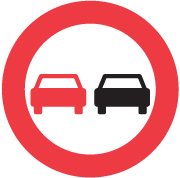



Drivers who encounter each other, must keep to the right. They must keep a sufficient distance to the side between the vehicles and also demonstrate particular attentiveness to road users who are using the right side of the roadway. If the road is partially blocked, the vehicle on whose side the lane is blocked must, if necessary stop and allow the vehicles the driver encounters to pass.
When encountering vehicles that are used for road works, the driver must take necessary caution in a way that is the most appropriate.
Overtaking must be done on the left. However, overtaking must be done on the right of a vehicle if the driver is turning to the left or is clearly preparing to carry out such a turn. Cyclists and drivers of small mopeds can overtake vehicles of other kinds on the right.
Regardless of this, overtaking while observing particular attentiveness occurs on the right of light rail vehicles if the light rail vehicle does not block the visibility across the roadway to such a degree that overtaking cannot occur without danger or inconvenience to others.
Drivers who want to overtake must ensure that this can be done without danger, including in particular:
The overtaking vehicle must keep a sufficient distance from the side between his vehicle and the vehicle or light rail vehicle that is being overtaken. If overtaking occurs on the left, the vehicle overtaking keeps to the right as soon as this is possible without danger or inconvenience. However, the vehicle does not need to be driven back into the lane to the right if the overtaking vehicle, after overtaking, has the intention to immediately overtake yet another vehicle and the conditions for overtaking in general are met.
Vehicles that are used for road works, can with the necessary caution, be overtaken in a way that is the most appropriate.
When a driver in front becomes aware that a vehicle from behind will overtake on the left, the relevant vehicle must keep as far to the right as possible and may not increase speed.
If a vehicle is driving at a low speed or occupies a lot of space, and the roadway is narrow or winding, or there is oncoming traffic, the driver must be especially aware of traffic coming from behind. If it can make overtaking easier, the driver must reduce speed and, if necessary, drive the vehicle out to the side as soon as this is possible and possibly stop completely.
Overtaking is not allowed:
These prohibitions do not apply to overtaking of bicycles and small two-wheeled mopeds.

The prohibition does not apply to overtaking of bicycles and small two-wheeled mopeds. The prohibition does not apply to overtaking vehicles that turn off the road. The prohibition applies regardless of the regulation in Section 16, item 2, until it is nullified with the discontinuance sign or with distance indication on the plate below the sign. The plate below the sign can state exactly in which time period the prohibition applies.
Be ready for the theory test
You will have access to more than 1,000 multiple choice options. Our theory tests have been tested on more than 140 students before we launched it. Everyone passed the first time.
Drivers who approach a pedestrian crossing may not carry out overtaking or drive past another vehicle if this vehicle prevents full visibility of the pedestrian crossing.
If the traffic is congested and it moves in several lanes with a speed that is decided by the driver in front, it must not be considered as overtaking if a vehicle in a lane drives past a vehicle in another lane. In such case, changing lane is not allowed unless required according to Section 16, item 1, Section 17, item 1, Section 18, items 3-5 or it occurs in order to park or stop.
If a vehicle driven in a lane which, by way of marking, is reserved for a certain type of traffic, drives past a vehicle in another lane that is not reserved for such type of traffic, or is driven past, this is not considered as overtaking.
Section 16. In those cases where the roadway has two or more lanes that are reserved for traffic in the same direction, the driver must position his vehicle in the lane far to the right in good time if he is going to turn to the right and in the lane furthest to the left if he is going to turn to the left. The driver who will drive straight on can position his vehicle in the lane which, in consideration of the other traffic and the continued driving, is the most appropriate.
Section 17. Section 16, items 1-3 also apply to driving across or away from the roadway outside of the junction.
Item 3. In the acceleration lane, the driver must adjust the speed to the traffic in the lane, which must be used during the continued driving and leave the acceleration lane when this can be done without danger or unnecessary inconvenience to others. Drivers in the lane which the traffic in the acceleration lane will drive into must, if necessary, ease the moving out of the acceleration lane by reducing speed.
Item 5. The deceleration lane must be used immediately at the beginning of the lane. The same applies to lanes that are reserved for a certain type of traffic, as well as lanes that are used for turning.
Take a 12-question subject test - requires Platinum access.